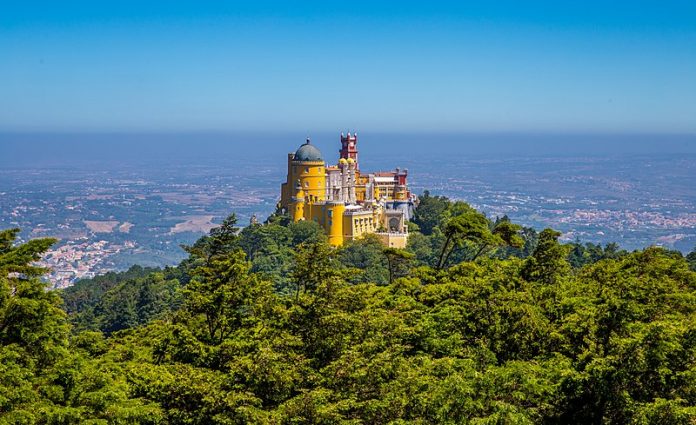
This great Sintra Guide showcases the best places to visit in Sintra if you only have one day to explore Portugal’s crown jewel town with fairytale palaces.
There are so many awesome places to see in Sintra. Truth be told one day in Sintra is a bit short, but let’s see what we can fit into a magical one day itinerary.
Sintra is a UNESCO World Heritage site and is one of the best places to visit in Portugal.
Sintra’s main attractions include a number of the beautiful palaces set in stunning locations including Pena Palace, and the historical Moorish castle set high on a hill offering commanding views over Sintra town and the impressive surrounding landscapes.
What more do you want? Oh, I should also mention the beautiful lush gardens, the spectacular pine-covered hills, the calm soothing pools of water, and the statues of the Greek Gods waiting to greet you.
Sintra has its own magical micro-climate which explains all that lush greenery. It wasn’t at all what I expected to see in Portugal. I was very pleasantly surprised.
It is almost worth visiting Portugal just to see Sintra alone, but thankfully there are plenty of other awesome places to visit in Portugal.
I rate my own visit to Sintra as being in my top 3 day trips of all time, if not the best.
If you haven’t considered visiting Portugal before then this post could easily inspire you to change your mind.
The history of Sintra
Sintra or “Cintra” has been linked to moon Goddess worship in the past.
The name Sintra originates from ‘Cynthia’ who is the Roman goddess of the moon.
Cynthia is an epithet of the Greek Goddess Artemis. According to legend the Goddess was born on Mount Cynthus, the highest mountain on the island of Delos in Greece, together with her twin brother Apollo.
The Sintra mountains are considered to be the legendary retreat of Artemis (Diana the Huntress, known as Cynthia to the Romans – from the Greek Κύνθια, hence Çintra).
It’s no wonder Portugal’s wealthy and elite chose to build their romantic palaces and castles in Sintra surrounded by beautiful gardens atop the hills of the Serra de Sintra (Sintra Hills).
In more recent times pop icon Madonna purchased a superb property in the romantic hilltop town of Sintra. She became the owner of the 18th century estate of Quinta do Relógio in the heart of town. This beautiful pond in the private estate proves to me anyway that she has some fantastic taste in property.
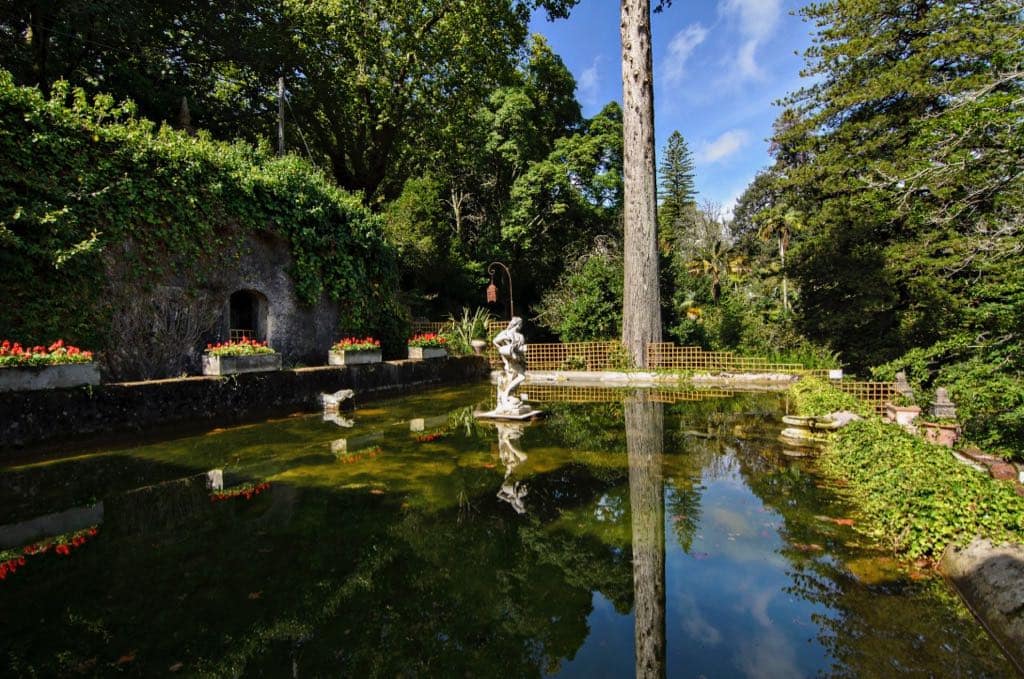
Today, Sintra is one of the most popular day trip attractions in Portugal. Tourists love the place and I’m one of them. I love, love Sintra!
Where is Sintra located?
Sintra is located about 30km (18 miles) from Lisbon, the capital of Portugal.
Visiting Sintra is a great day trip to go on when you’re in Lisbon. The train can take you there in about 40 minutes and it’s so worth getting up a bit early to enjoy the easiness of taking the train.
Don’t drive there unless you have someone of Portuguese origin in the car with you. The biggest hassle will be the oneway narrow streets and finding parks (near impossible in peak season). The train is the best way to get to get to Sintra.
There are multiple ways to get around Sintra once there including buses, taxis, Uber, mini cars and tuk-tuks. Sintra is well known for its tuk-tuks. You will find them everywhere, even outside the train station. They are safe and relatively cheap, just make sure you negotiate a set price before you hop on.
The best attractions in Sintra
The biggest drawcard in Sintra is Pena Palace, a spectacular palace perched on its own hill. It is an unbelievable sight to behold from a distance. Who wouldn’t want to visit this amazing palace?

Even though you would think that nothing could beat Pena Palace in Sintra, my own personal favourite place to visit in Sintra was Quinta da Regaleira. I’ll discuss this a bit later.
Sintra has beautiful gardens filled with lovely flowers, majestic forests and serene lakes that will make you forget about everything, apart from the beauty before your eyes.
If you like the colour green you’ll be in heaven because Sintra is a lush paradise, so not what I expected to see, especially when you’ve seen some of the drier places in Portugal.
Visiting Sintra is definitely in my top 3 best day trips of all time, if not the best.
Seriously it’s that good. I can’t recommend visiting Sintra highly enough. It’s actually worth planning an entire trip around.
Don’t just take my word for it: Renowned Portuguese poet Luís de Camões referred to it as a mythic land ruled by water nymphs.
Lord Byron famously referred to Sintra as a “glorious Eden” and likened it to the Elysian Fields of Greek mythology. Hans Christian Anderson described it as the most beautiful place in Portugal.
Best places to visit in Sintra in 1 day
Choosing the best places in Sintra to visit in one day wasn’t that difficult. The 6 best places in Sintra I think everyone should visit are:
-
- Monserrate Palace
- Quinta da Regaleira
- Sintra National Palace (very briefly)
- Pena Palace
- Pena Park, the Lakes and Gardens
- Castle of the Moors
If you take this advice on board I’m sure your day trip to Sintra will be awesome!
During my visit to Sintra I actually missed on the Castle of the Moors and Monserrate Palace because I didn’t plan anything. I also arrived at Sintra a bit later in the day. You can learn from my mistakes.
Here are the best places to see in Sintra with a few tips so you can experience the best day trip in Sintra possible.
Sintra Guide: The best itinerary for a great day trip to Sintra
This well considered itinerary will require you to arrive in Sintra by 9am. Set your alarm clock early and make it happen. This will hopefully be one of the best days of your life.
You could easily stay in Sintra for two or three nights, but in this post I’m recommending a fabulous one day itinerary to explore Sintra so you can see as much as possible.
This is based on my own awesome day trip to Sintra, which would have been even better if I had followed this very helpful Sintra Guide. Live and learn.
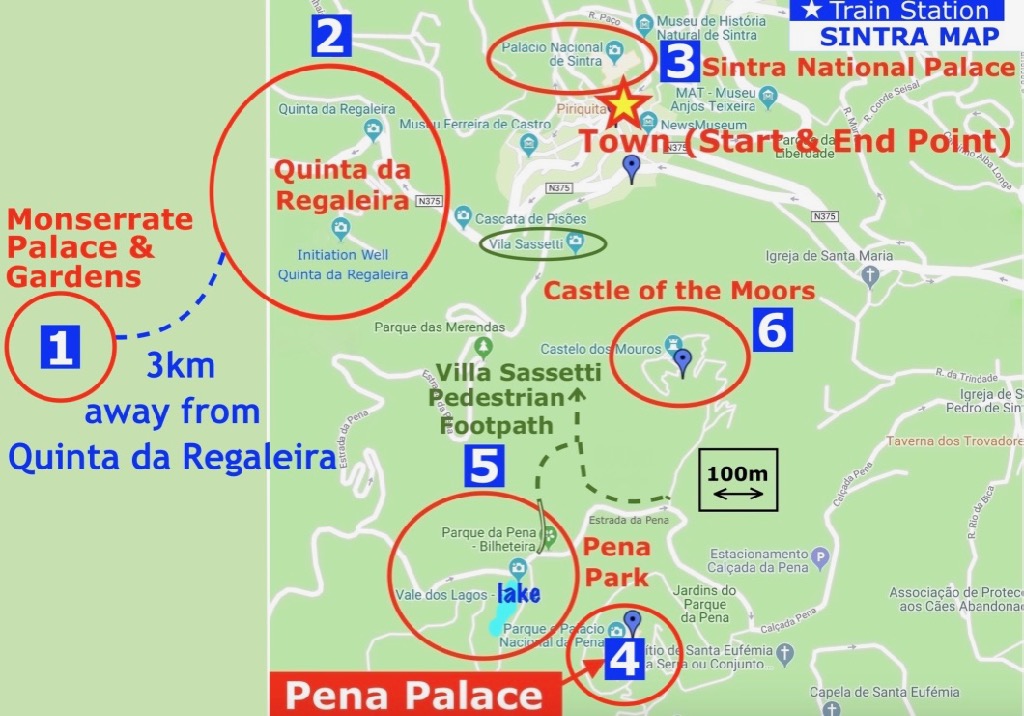
Even though certain attractions will feel a bit rushed, you’ll still have an awesome day trip in Sintra, much better than my exquisite visit.
The best highlights in Sintra can be visited in one day, you just need a great itinerary plan like this one to make the most of the day.
If you’re in Portugal there’s no excuse, you can’t miss Sintra especially if you’ve never been there before. It’s a must visit destination, like going to Capri if you’re lucky enough to be in Italy’s Amalfi Coast region.
When I visited Sintra I have to say I didn’t know much about the place at all. I thought I’d see a couple of old palaces and maybe a castle, and that would be about it.
I had visions of drinking a cup of coffee in a cafe high up on a sparse mountain somewhere taking in the awesome dryish views, but not much more than that.
Wow, I couldn’t be more wrong. Sintra is a breathtakingly beautiful place filled with lush greenery. It’s like being in a real life fairy tale, I kid you not.
Let’s take a closer look at the best places to see in Sintra.
1. Monserrate Palace
Time: 9:30am – 10:30am (1 hour)
Start your day at Monserrate Palace as soon as it opens.
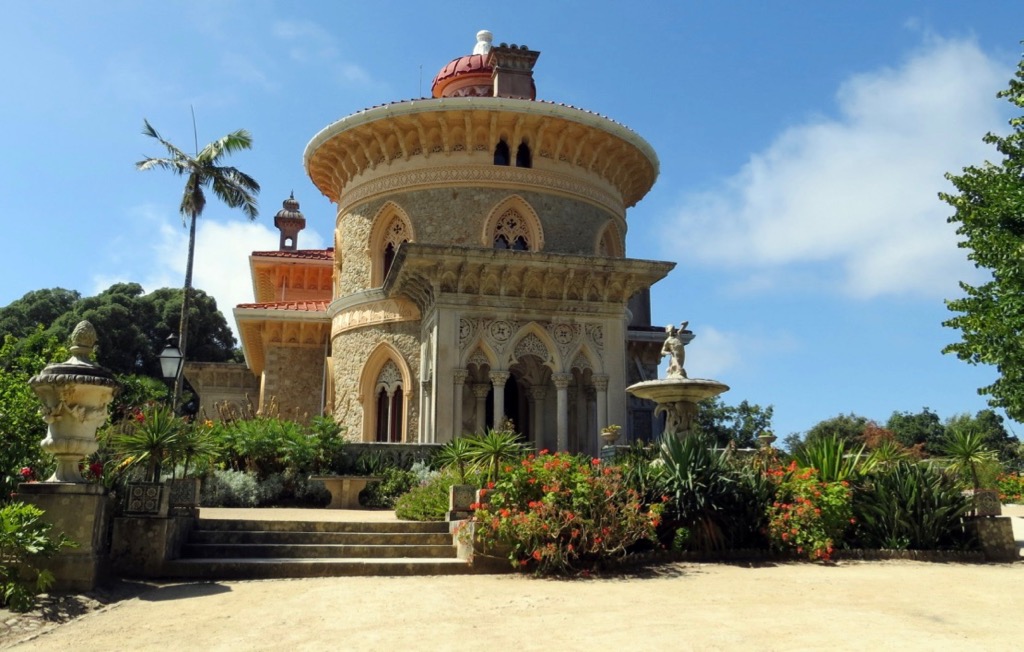
The Palace of Monserrate is one of Sintra’s hidden gems. This recommendation is a bit different to what others might suggest to do.
Many tourists miss out on this beautiful palace entirely, not on purpose, but often because they didn’t know about it in the first place.
Even when tourists know about Monserrate Palace they often skip it due to time constraints. I think Monserrate Palace is 100% worth a visit, so make it your first stop.
It blends Indian, Moorish and Venetian Gothic architecture together, and there is a large beautiful botanical garden made up of plants from around the world garden. You might not guess otherwise without knowing, but it was commissioned by an Englishman!
This beautiful estate is located a bit further up the road from Quinta Da Regaleira. It’s too far to walk there from the old town so make use of the numerous transport options available to get you there. Make sure you’re there by 9:30am. If you arrive 15 minutes earlier even better.
I’m only allowing 1 hour here but it’s a great way to start the day. It’s supposed to be a very tranquil place of great beauty.
Your time allowance is only for a quick look around. The main lush green lawn will stand out, as will Beckford’s Waterfall, and the Palace of Monserrate.
You will be in garden heaven at this beautiful estate.
This palace was actually a summer residence for an Englishman named Sir Francis Cook.
Palace: 9:30am – 7pm (Last ticket sold at 6:15pm, last entry at 6:30pm)
Park: 9:30am – 8pm (Last ticket sold and last entry at 7pm)
2. Quinta da Regaleira
Time: 10:30am – 1:30pm (3 hours) including time to get there
The best places to visit in Quinta da Regaleira
1. The Mansion (Palace)
2. Promenade of the Gods
3. Leda’s Grotto and Regaleira Tower
4. Portal of the Guardians
5. The Initiation Well
6. Tunnels to the Lake of the Waterfall
7. The Terrace of the Celestial Worlds
Tip: On arrival make sure you pick up a map at the ticket counter. The estate is a large 4-hectare (about 10 acres) wooded park so you will definitely need a map of the entire estate to find places of interest, and so you don’t get lost.
Wandering around at your own pace is probably the way to go, however, if you prefer you can go on a guided tour if the timing is right. The guided tour of Quinta da Regaleira is supposed to be great.
1. The Mansion, Quinta da Regaleira
When I was making my way to Quinta da Regaleira I had no idea what to expect. My first clear glance of the building was one of total amazement. Who was this weirdo who built this weird gothic looking building?
If I had seen an Edward Scissorhands type person or even a vampire walk out the front door I wouldn’t have been surprised at all. The same goes for the Beast from Disney’s the Beauty and the Beast. Maybe a wizard from Harry Potter’s Hogwarts School owned it.
Never in my wildest dreams did I expect to find the Greek Gods inside the estate. Hermes (Mercury), the Greek God of travel is right in front of the main building.
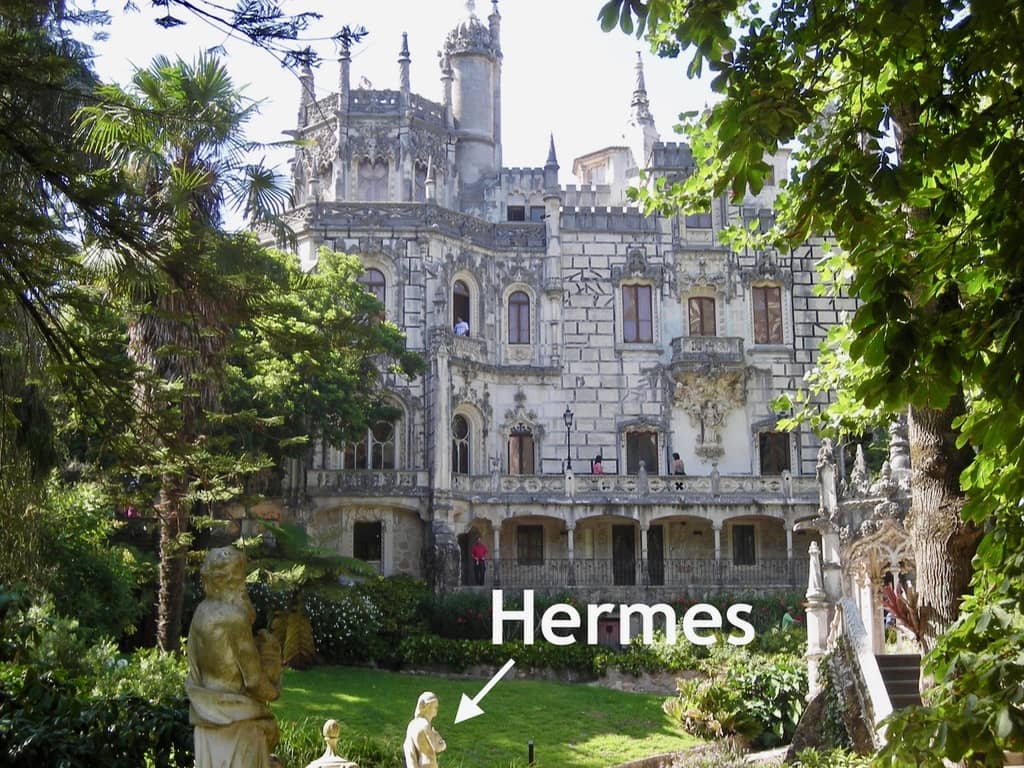
This building was apparently originally pure white when first built but it has settled with age on a creepy greyish tone. The building itself looks much more like a haunted house than a mansion or palace.
Quinta da Realeira turned out to be my own personal favourite place in Sintra and many other tourists seem to agree with me.
The gardens are magical, the greenery is very lush and beautiful, and the whole place exudes a serene environment. On top of that are all of mysteries all over the estate.
Regaleira Palace is the most important building in the property and features Gothic-style architecture, with a heady mix of Moorish, Egyptian, Neo-Manueline, and Renaissance features. It was the Italian architect Luigi Manini who played an important role in its creation.
The palace consists of five floors including the ground floor, three upper floors and a basement, with a balcony and a terrace allowing you to take in the stunning views.
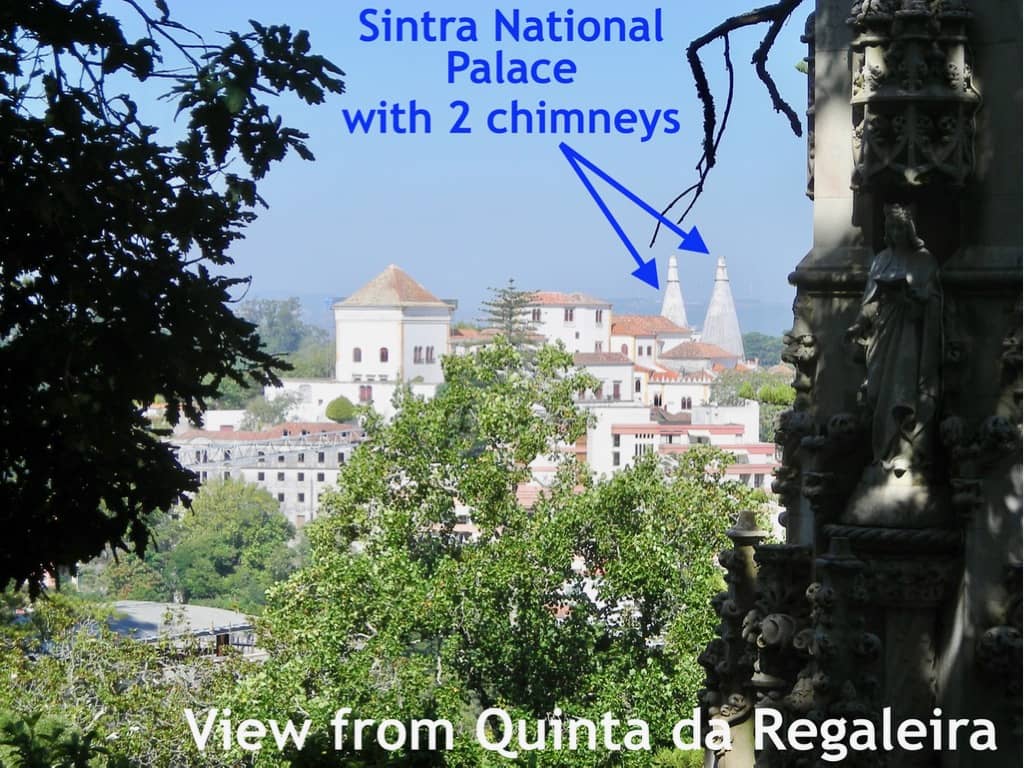
You have to go inside. That’s not all, this very unique building is on a fantastic estate of about 4-hectare (about 10 acres). Walking around the estate is the biggest highlight.
History of Quinta da Regaleira
Quinta was originally a summer home that belonged to the Viscountess of Regaleira.
A few families had owned the estate previously but in 1892, the Viscountess sold it to the eccentric millionaire, António Augusto Carvalho Monteiro.
Monteiro was born in 1848 in Rio de Janeiro, Brazil, and eventually became a Brazilian coffee magnate.
At some point in his life he developed a strong interest in Hermeticism, a philosophy that believes wisdom is attained through the contemplation of the mysteries of the universe. Another core belief was that nature offered a way to help bring purity and realisation of profound truths.
The estate as you see today was completed sometime between 1898 and 1912.
In addition to seeing a few of the Greek Gods on the estate, you’ll also see symbolism and allusions associated to religion, alchemy, Freemasonry and the Knights Templar.
You will be bamboozled trying to get inside this guy’s head. What was António Monteiro thinking? Maybe he wanted to confuse everyone.
The weirdo palace is also known as the “Palace of Monteiro the Millionaire”, from a nickname he had gained due to his immense wealth.
Since 2002 the house and estate have been classified as a National Monument, preserved by the Sintra cultural foundation.
2. Promenade of the Gods, Quinta da Regaleira
The true beauty of Quinta da Regaleira however lies in the enchanted gardens. A great way to start your adventure off is to walk down the Promenade of the Gods.
Just head towards Greek God Hermes (Mercury) in that direction, located right in front of the palace (mansion).

Keep an eye out for these Greek and Roman God statues on the Promenade of the Gods. The nine statues in the collection include:
Dionysus (Roman name: Bacchus) – God of wine and revelry
Orpheus – The greatest singer in the world at the time
Vulcan (Greek name: Hephaestus) – God of metal
Ceres (Greek name: Demeter) – Goddess of crops, and how the word cereal came about
Pan – God of the woods and wild nature
Fortuna – Goddess of fortune and the personification of luck
Hermes (Roman name: Mercury) – God of travel, politicians, and commerce
Flora – Goddess of flowers and plants
Venus (Greek name: Aphrodite) – Goddess of love
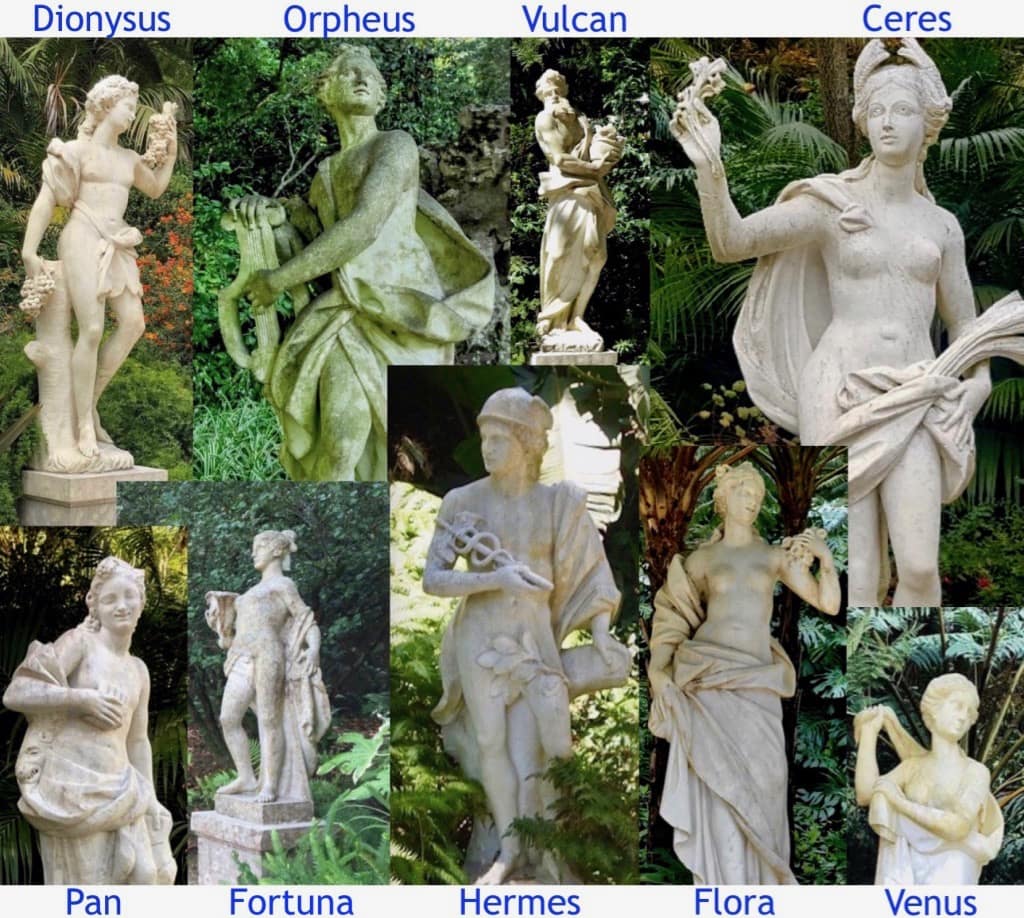
The “Promenade of the Gods” is on an avenue that links the Pisoes Loggia to the main house.
The Pisoes Loggia is a Neo-Manueline structure which provides a side entrance to the gardens of the Quinta da Regaleira. It was obviously a great shortcut.
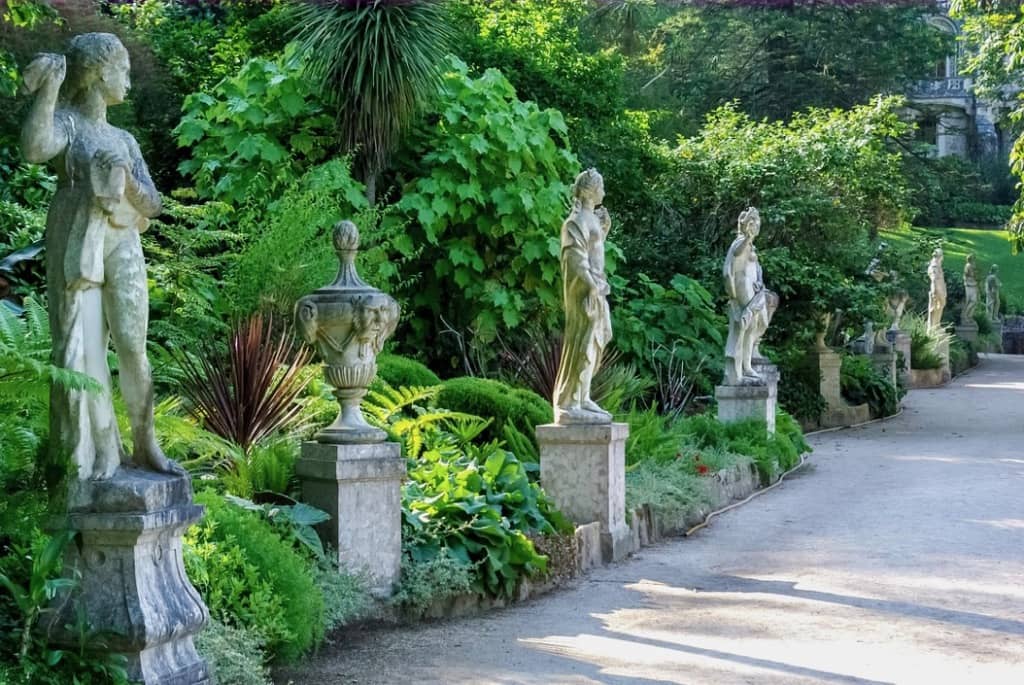
The classical marble statues along the Promenade of the Gods are often intertwined with the plants. You’ll also be able to see a lead sculpture of a lion close by.
At the end you can find the Labyrinthic Grotto. After you visit the Labyrinthic Grotto it’s time to make your way to Leda’s Grotto and the Regaleira Tower.
3. Leda’s Grotto and the Regaleira Tower, Quinta da Regaleira
You will obviously want to climb up to the top of the tower. Great views of estate, Sintra and the Moorish Castle can be seen at the top.

Leda’s cave lies beneath the Regaleira Tower. Leda and the the swan is a reminder of the power of Zeus, when he turned into a swan to seduce Leda.

4. Portal of the Guardians, Quinta da Regaleira
The Portal of the Guardians is an entry/exit point to the Initiation well. I don’t recommend entering at this point.
If you do decide to follow the tunnel it will take you to the bottom of the Initiation Well, a “subterranean tower” that sinks some 27 meters into the earth.
That means you’ll arrive at the Initiation well at the bottom of it for the first time, which is ok, but there is a better way. I’ll go into more detail when I discuss the Initiation Well next.
The guardians are two lizard type creatures clinging to a sea snail at the centre with two towers on either side.
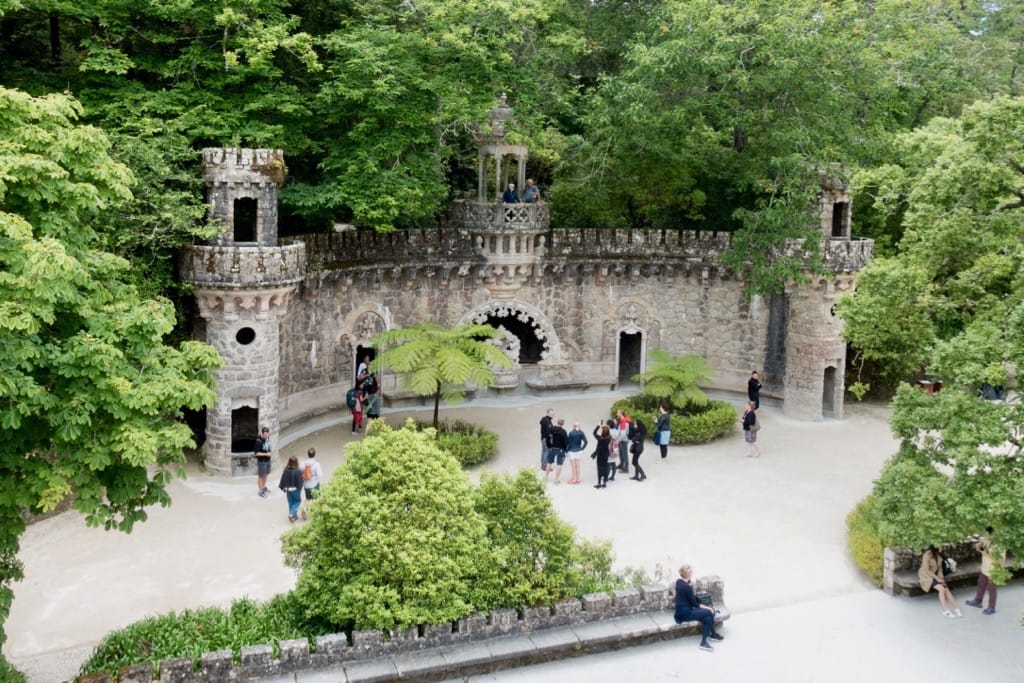
Take a look around but don’t enter the central pavilion, under which is a hidden way to the Initiation Well.
It’s much better to walk to the Initiation Well. You can follow the signs or use your map to get you there.
5. Large Initiation Well, Quinta da Regaleira
There are two wells on the property, a larger well and another one known as the Unfinished Well. The larger well is the superior well. Both walls of the wells are covered with mosses.
The larger Ignition Well is about five floors high. It contains a 27-meter spiral staircase with nine small round landings, separated by fifteen steps. Believe it or not, but this Initiation Well is the main drawcard to this mysterious property.
You’re probably thinking how come? Well, because it’s very mysterious. The wells were never used to hold water but rather to initiate members into the deeper mysteries of life.

Symbolism associated with the Initiation Well
The journey of the initiate is linked to Tarot mysticism, Masonic, Esoteric, Alchemical and ancient Greek symbolism. It’s a Pans Labyrinth meets Dan Brown kind of experience.
It seems as if there are references to Dante’s Divine Comedy where Nine Circles of Hell, Nine Sections of Purgatory and the Nine Skies of Paradise are mentioned. If you’ve read Dante’s Divine Comedy you should be aware that the Greek Gods also play a major role in it.
The Divine Comedy is divided into three parts: Inferno (Hell), Purgatorio (Purgatory), and Paradiso (Greek Gods Paradise). It’s a poem representing the soul’s journey towards the Greek Gods.
The symbolic meaning of going down the Initiation Well a kind of death/rebirth allegory or heaven and earth experience, common to many hermetic (Hermes) traditions.
It symbolises a bridge between earth and Greek Gods Paradise (Heaven). At the bottom of the well you’ll see the sky which will give you the connection between earth and heaven.
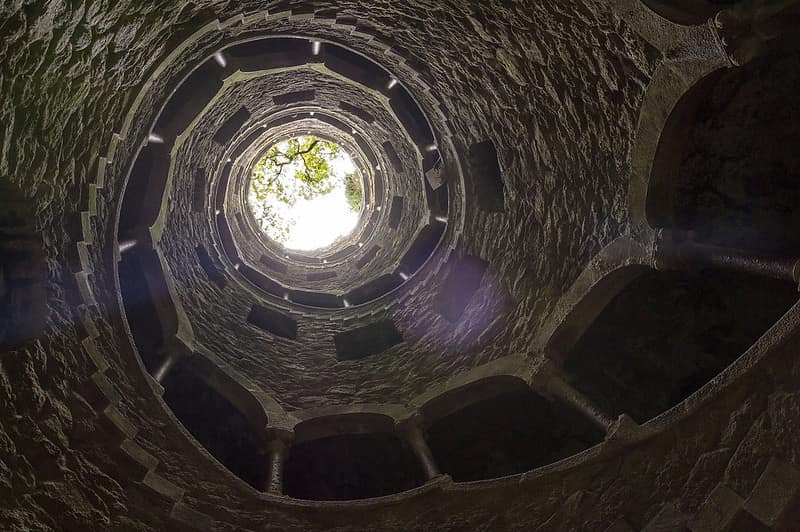
Depending on the direction the adept chooses to walk, it represents either a journey through Mother Earth’s womb (going down the Initiation Well and exiting via a tunnel), or a rise up into the light, if you enter at The Portal of the Guardians and climb up the stairs of the Initiation Well.
My Recommendation – Walk down the Initiation Well
Follow the unique spiral staircase all the way to the bottom of the Initiation Well (inverted tower) and exit at The Lake of the Waterfall.
When you see the beauty of the greenish pond after being in semi-darkness, it’s like nothing else.
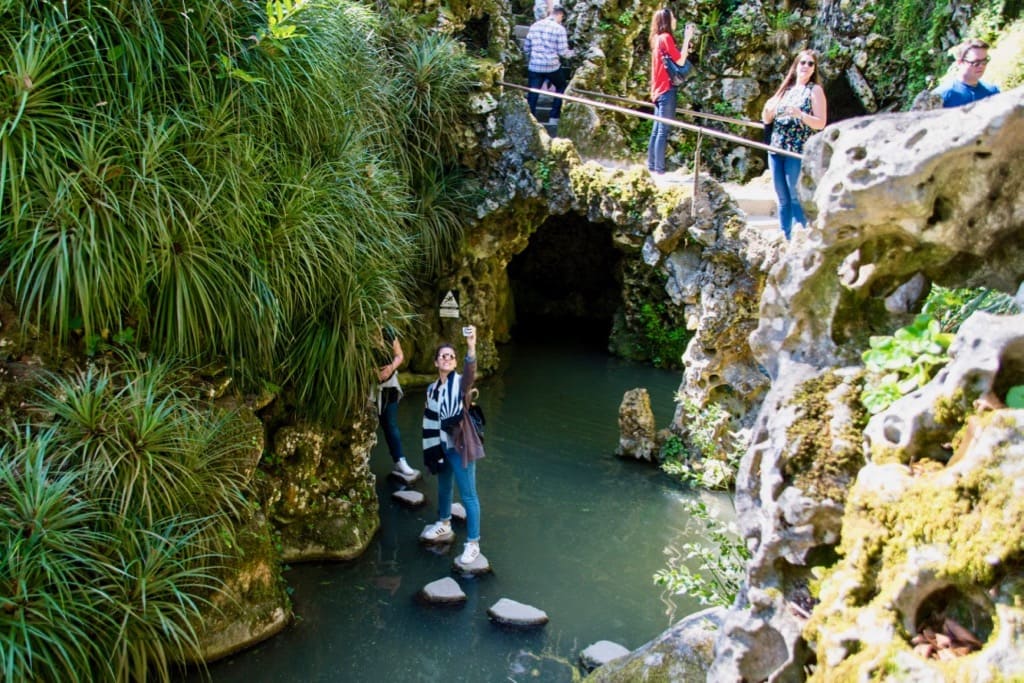
It’s like experiencing a symbolic purification. It is a popular spot in the estate so you’ll probably find a number of other people lining up to descend down the Initiation Well depending on the time of day, so be patient!
After you’ve made it all the way down to the bottom of the well and looked up at the sky numerous times, you can then exit via a labyrinth of tunnels at the bottom.
6. Tunnels to the Lake of the Waterfall, Quinta da Regaleira
The tunnels at the bottom of the Initiation Well take you to other parts of the estate. They could take you to the Portal of the Guardians, the Unfinished Well, the Grotto of the East, or the Lake of the Waterfall.
A string of fairy lights similar to the thread that Ariadne gave Theseus so he could find a way out of the Minotaur’s labyrinth will also be able to assist you in finding your way out of these labyrinth tunnels.
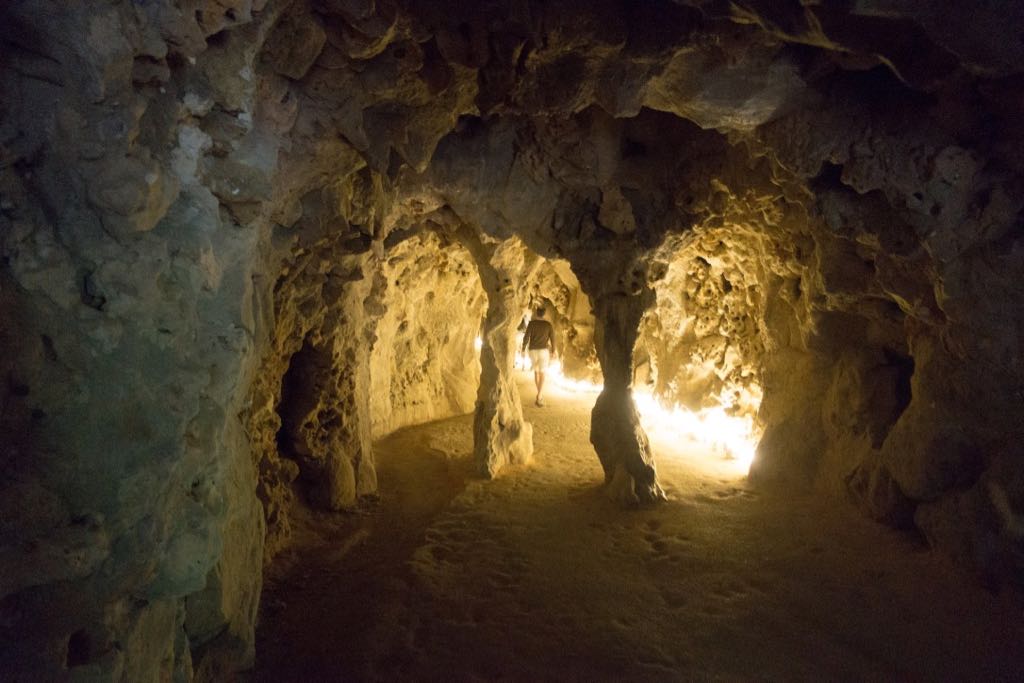
Tip: Bring your own small lightweight LED head light or use the torch on your cellphone to get around the caves a bit more easily. Lighting in the tunnels isn’t that great. It’s actually quite dark and dingy inside.
I have already suggested taking the tunnels that will lead you to the Lake of the Waterfall. It’s on the way to the Unfinished Well and the Grotto of the East, though you turn off before that.
If you want you could go to the Unfinished Well first and then turn back to exit via the Lake of the Waterfall. The turn-off for the Lake of the Waterfall exit is about half way between the large Intitian Well and the Unfinished Well.
Exit the Initiation Well via the tunnel to the Lake of the Waterfall
At the Lake of the Waterfall exit, you’ll have to walk across a beautiful pond with stepping stones below the waterfall, so keep your balance.
There is nothing to hold onto and you don’t want to fall in and make a fool of yourself by getting wet in this slimy green pond. I’m sure a few unfortunate visitors have.
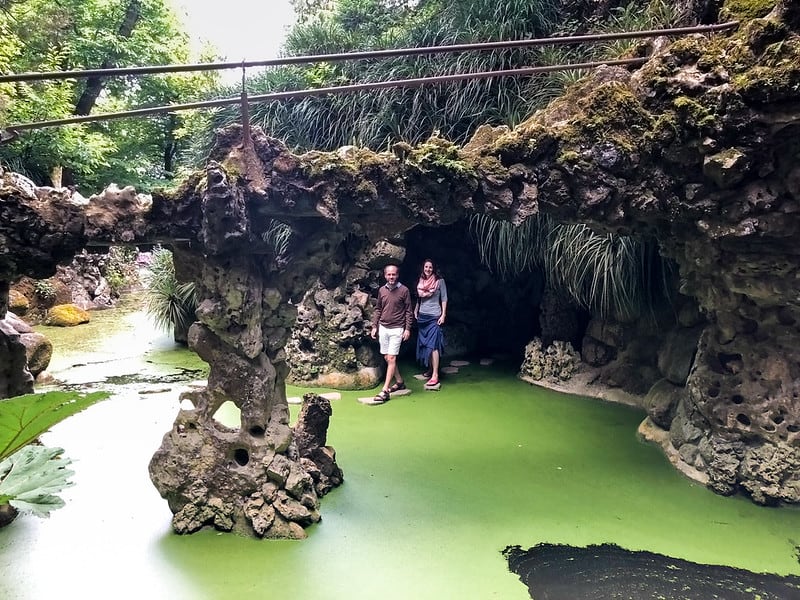
If you’re a cave person you may want to explore all of the tunnels, but I felt a bit claustrophobic down there and was glad to escape.
If you’re really cave intolerant you always have the option of climbing back up the stairs to the top again after you’ve reached the bottom of the well.
That tiny light you see in the distance when you’re existing a tunnel is divine. I was so glad to have seen the light.
You can download a PDF Map of Quinta da Regaleira showing where the tunnel routes are located. The tunnels can be seen on the second page of this map. The first page shows the intricate building plan.
7. The Terrace of the Celestial Worlds, Quinta da Regaleira
Now it’s time to contemplate what to do next. I recommend going to The Terrace of the Celestial Worlds where you can study your map and see if there is anywhere else in the estate of Quinta da Regaleira that you would still like to see.
Wandering through the garden is said to represent an initiate’s metaphysical journey through the cosmos towards enlightenment. Maybe you’ll start feeling a bit different.
Go for a wonder around the gardens and see what else you can discover.
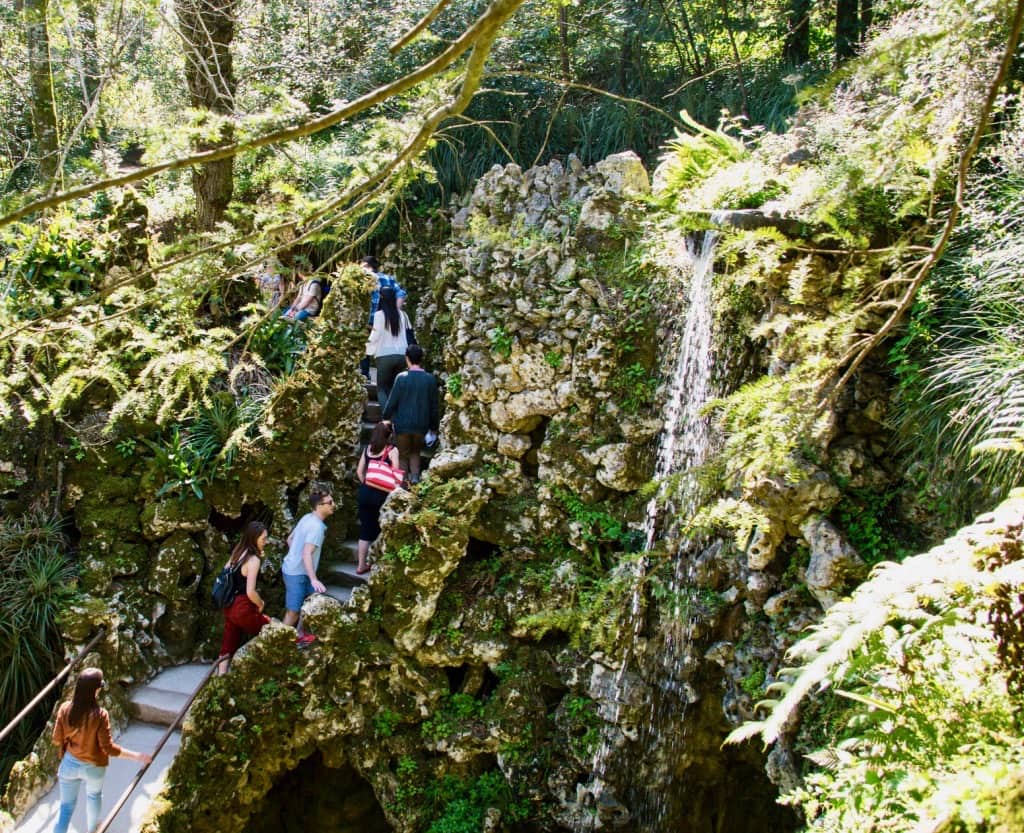
Make your way to Sintra old town for lunch: 1:30pm – 2pm
From Quinta da Regaleira, you can walk (15 minutes) in town. Alternatively, you can take a bus or a tuk-tuk into town. Transport is quite cheap in Sintra, so going by tuk-tuk is a good option as well.
Stock up your small day bag with a few tasty treats as well to replenish your energy when required. There is a lot of walking still to do. You may have to eat while your walking around or when you’re waiting to enter the Sintra National Palace.
Make sure you keep to the timing of the itinerary plan, otherwise you’ll probably miss out on something.
If I were to miss out on anything it would be the Sintra National Palace. It didn’t do too much for me. Remember you only have 1 day in Sintra, so you need to pace yourself.
3. Sintra National Palace (Palacio de Sintra)
Time: 2pm – 3pm (1 hour)
The iconic palace is located in the heart of Sintra’s old town so it’s easy to walk to.
Sintra National Palace is white and it has two large chimneys measuring 33 meters high so you can’t miss it. You can always get your bearings in Sintra by looking out for these two huge chimneys, which are a trademark of the village of Sintra.
Initially I couldn’t figure out what the two huge chimneys were. I wondered whether it was a nuclear power station. It really made my mind boggle.
If there was only one chimney I would have concluded that it was a chimney, however because there were two of them I wasn’t sure.
After a while I concluded that they must be fireplace chimneys but I was wrong, both of the double cone chimneys are for the humungous palace kitchen with two enormous ovens.

Enter the palace no later than 2pm and make sure you leave by 3pm at the very the latest.
Sintra National Palace (Palacio National de Sintra) turned out to be my least favourite of all the places I visited in Sintra.
Some of you may like it though due to it’s interesting history and the unique decorative interior. The palace is considered to be the best preserved medieval residence in Portugal.
History of the National Palace of Sintra
The historic Palace of Sintra was first established sometime before the 10th century under Islamic Moorish rule.
Then came generations of Portuguese kings and queens who used the palace from the 15th to 19th centuries, making it the most-used royal residence in Portugal.
The palace suffered extensive damage in the 1755 Lisbon Earthquake, but it was later restored as accurately as possible.
Places to see inside the Sintra National Palace:
The Palace kitchen: where the cooks prepared delicious large-scale royal banquets.
Swan Room: with a beautiful ceiling decorated with images of swans.
The Magpies Room (Sala das Pegas)
Coat of Arms Room (Sala dos Brasões): a room with an impressive wooden ceiling that exhibits the coats of arms of King Manuel I and the main 72 noble Portuguese families.
The gardens were the biggest highlight for me, especially the green bushes and hedges which were manicured to perfection.
Bumping into Portuguese royalty at the palace is pretty low now. The palace was used by the Portuguese royal family until 1910, but after that it became a national monument.
Before leaving make sure you take a photo like this one from under one of the arches inside the palace looking out to the old town.
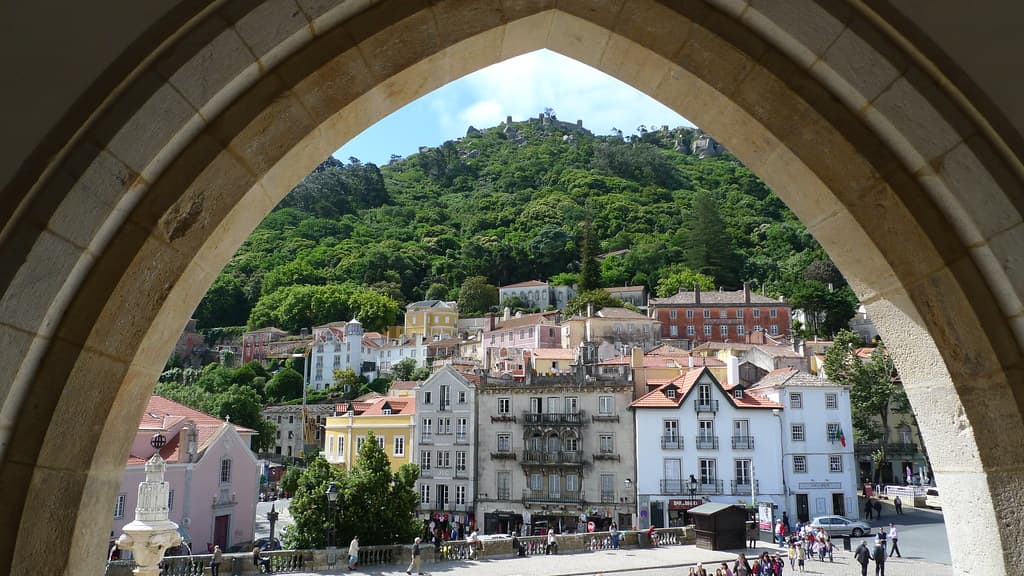
Opening times of Sintra National Palace:
9:30am – 7pm (Last entry at 6:30pm)
The Parques de Sintra website has more information on the National Palace of Sintra.
4. Pena Palace
Time: 3pm – 4:30pm
From a distance Pena Palace looks as if it has materialised from a fantasy movie. The first time I saw it I couldn’t believe my eyes, was I dreaming or something?
Pena Palace is the biggest attraction in Sintra. The multicoloured palace sits perfectly on the summit of Serra de Sintra (mountain of Sintra) and is surrounded by a wonderland of forest.
It is situated at the second highest point of the Sintra mountain range. Only Cruz Alta is higher, at an altitude of 528m.
If you were a knight in shining armour in search of the Holy Grail and you saw this palace, I’m sure you would be in total awe of this wondrous sight.
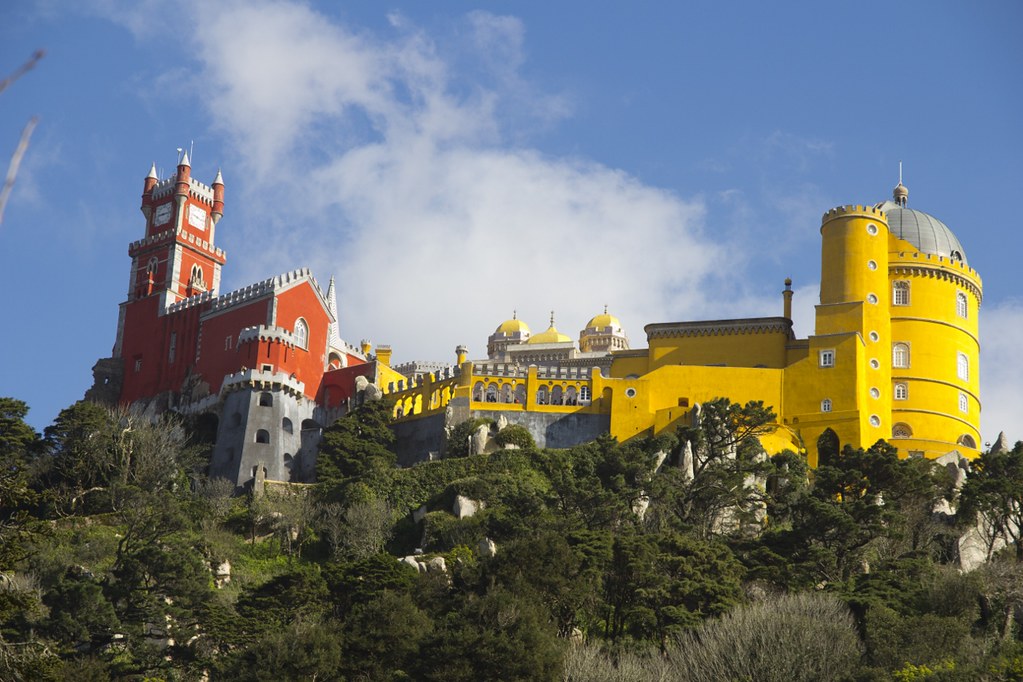
The beautiful bright multi-coloured palace is a spectacular sight to behold. For this reason it is the top attraction in Sintra.
History: The Palace was the summer home of King Ferdinand II, who restored the main building from a monastery in 1843.
How to prepare for your visit to Pena Palace
The lineup may seem pretty long to get inside during this time of day, but you will have to wait it out and hope for the best. Most recommendations will tell you to avoid visiting at this time of day as it is the busiest period, but the wait shouldn’t be too long.
Just make sure you have pre-purchased your tickets online, because you don’t want to waiting in the ticket line and be surprised to learn afterwards that you have to wait in the entry line.
From the entry gates you still have to walk for about 10 minutes to get to the palace, or the other option is to buy a ticket for the tram that will take you up to the door.
The wonderful views from Pena Palace go on forever. The views all round are breathtaking.
Here I am looking out from a terrace with vast views over Sintra.

This palace is almost fit enough for a Greek Goddess when you think about it.
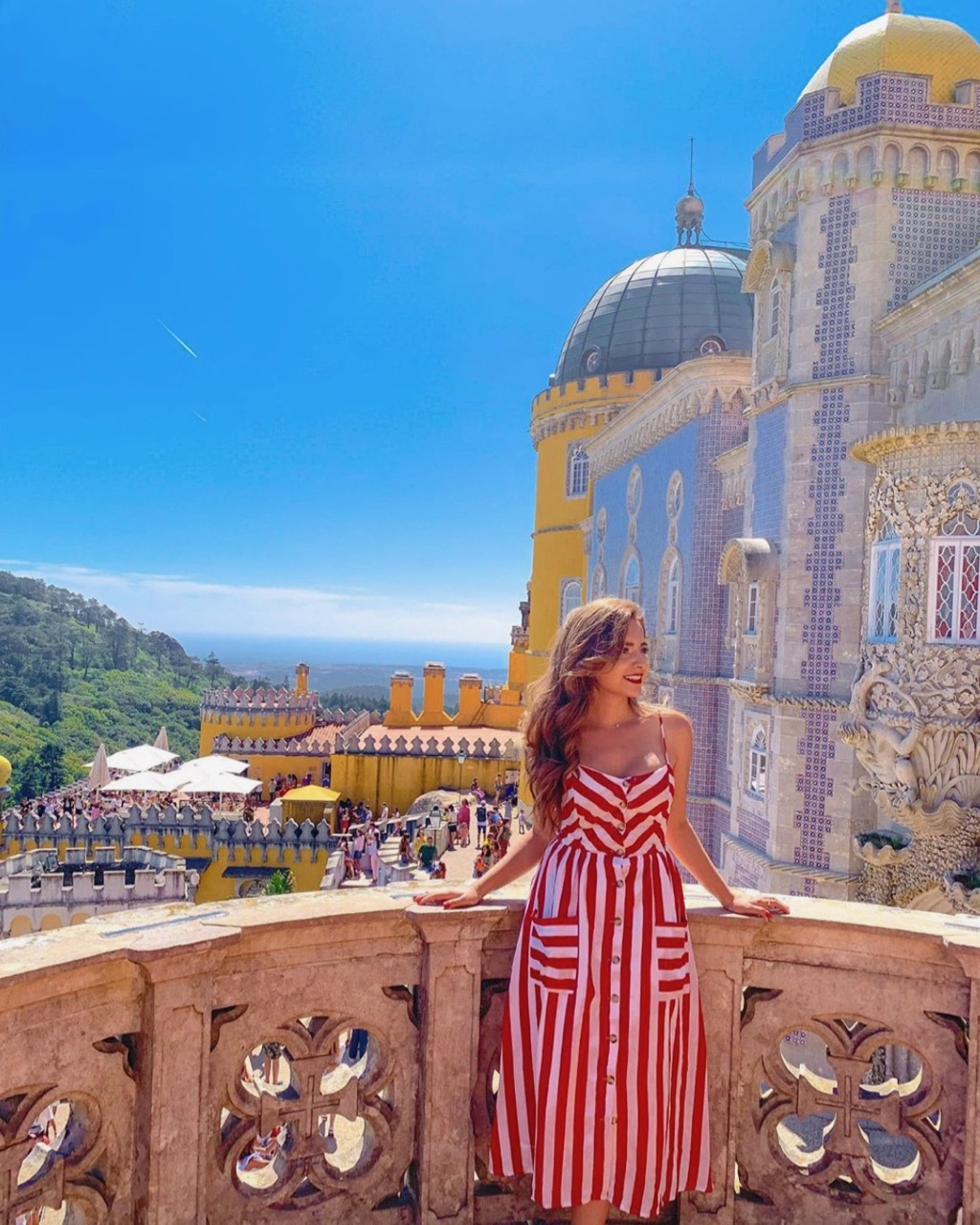
Instagram: @lapetitemangeuse
It’s not all pretty faces at Pena Palace though. What the hell is this hideous stone creature supposed to be? It sits on top of one of the main archway entrances. You can see a glimpse of the creature in the photo above as well on the righthand side.
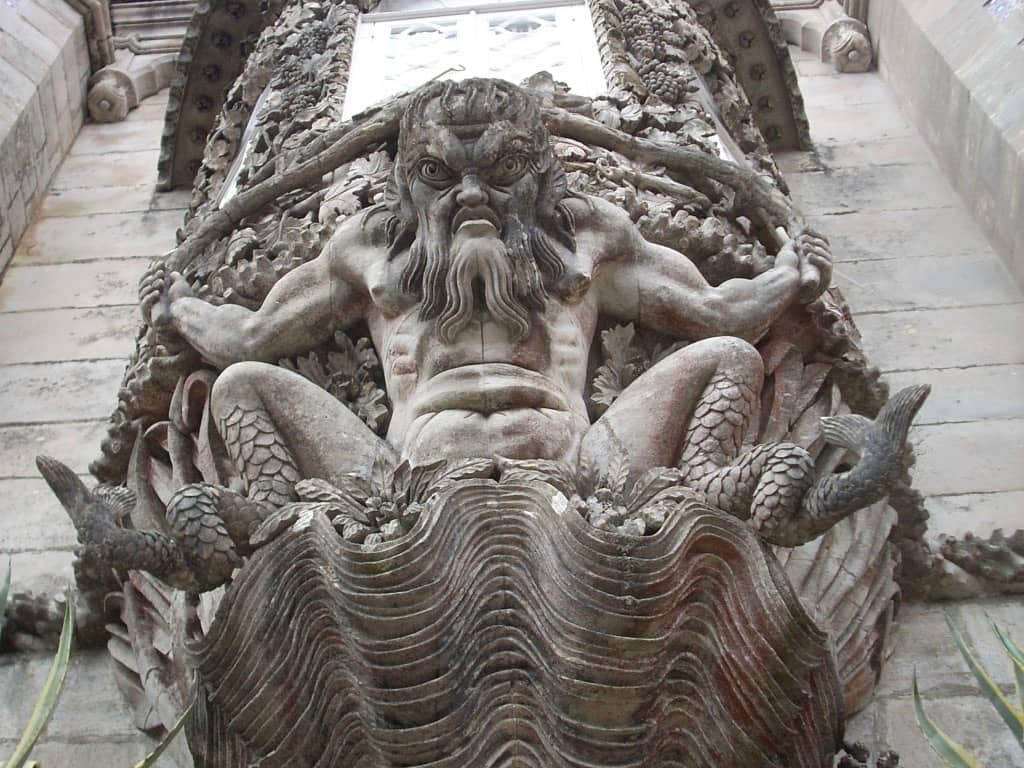
Some say it’s a Triton (half-man, half-fish) from Greek mythology, but I think it’s too ugly for that.
Tickets for Pena Palace
The cheaper “Parque” ticket provides entry to the Parque de Pena and access to the colourful terraces, courtyards and grounds.
The other option is to buy a ticket for the grounds and the indoor staterooms (Palace and park).
This means you have two types of tickets to choose from. I think I might have visited the staterooms very quickly but it was nothing memorable. The Sala de Visitas, Salão Nobre and Kings chambers may be of interest to you.
To save yourself valuable time and the hassle of waiting in the ticket line, make sure you buy your tickets online in advance. You can then walk right into the entrance queue by showing your tickets on your phone.
Opening hours: 9:30am – 7pm (last ticket 6:15pm)
Please check the opening times as they may vary from season to season, year to year.
How to get to Pena Palace
The only downside to visiting Pena Palace is that the palace is situated at the top of a steep hill, way above Sintra old town. If you’re a keen hiker it will take about an hour to hike up to Pena Palace from the historic town centre.
Based on this itinerary I strongly recommend using transport to get to Pena Palace. Don’t waste valuable energy hiking up the hill. The bus journey will take about 20-30 minutes.
It’s much better to walk downhill after when it’s time to leave. I’ll explain this soon.
After visiting Pena Place you can walk down to Pena Palace gardens and lakes (Parque da Pena).
5. Parque da Pena – The Gardens and Lakes
Time: 4:30pm – 6pm (1 hour 30 minutes)
Parque de Pena (the park) has more than 200 acres of forested land surrounding the palace, which is obviously way too much land to explore in only 90 minutes.
The ornamental duck lakes, the Warrior Statue and the Queen’s fern garden, are all connected by shaded footpaths.
You can even get a glimpse of Pena Palace from the duck lakes. The small structure on the lake is an ancient duck castle if you’re wondering.

Saint Catherine’s Heights offers stunning castle views. You might even want to visit Cruz Alta, at the higher altitude of 528m.
When I entered the gardens and lakes, I came across the “Valley of the Lakes,” a series of five lakes surrounded by lush forest. Even if you only see the beautiful lakes, it will be worth it.
Here’s a beautiful part of the lake to admire. I remember it well. You can also see another castle for the lucky ducks.
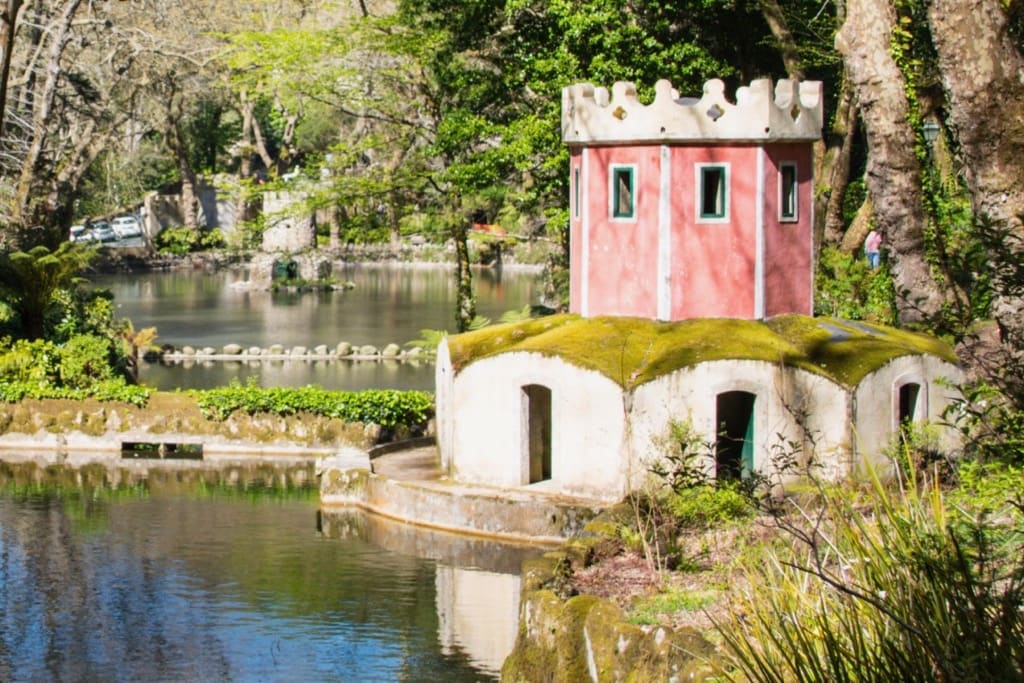
Keep an eye out for black swans and ducks gently gliding on the water. It must be good to be a duck in Sintra.
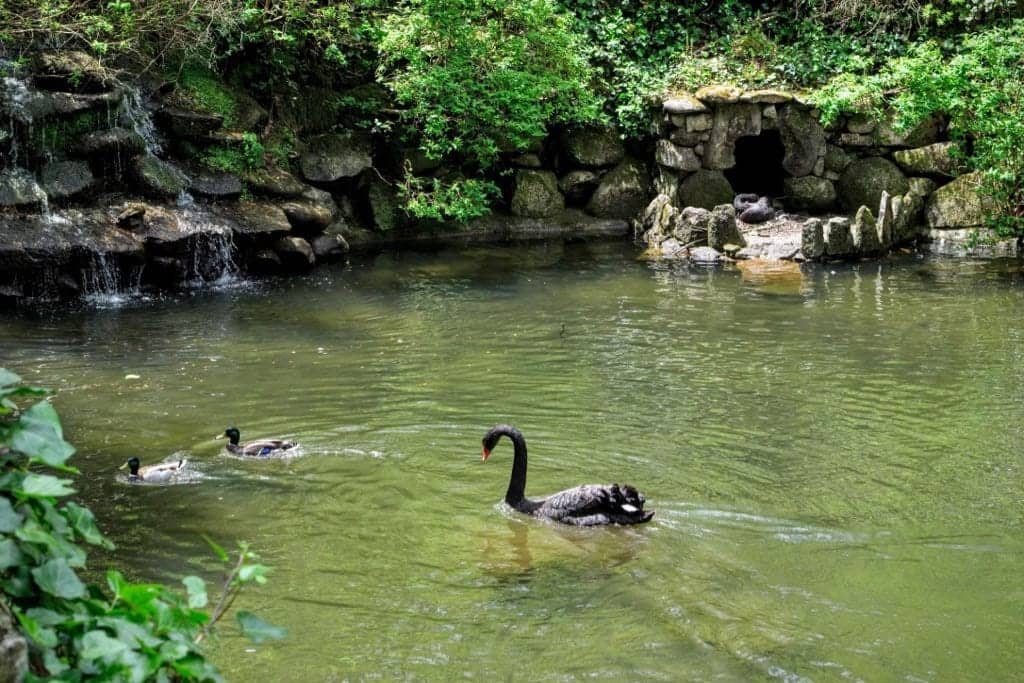
Opening hours: 9:30am – 8pm (last ticket and last admission is at 7pm)
After you’ve made your way to the Valley of Lakes, you can exit via the Lakes Entrance. Then it’s only a slight uphill walk to the Moorish Castle.
6. Castle of the Moors (Castelo dos Mouros)
Time: 6pm – 7pm (1 hour)
The magnificent Castle of the Moors (Castelo dos Mouros) is your next stop.
You can get to the Castle of the Moors quite quickly from Pena Park or Pena Palace, via pathways that connect the two major attractions. It will take about 15 minutes to walk there.
History of the Castle of the Moors (Castelo dos Mouros)
The Moors built the castle during the period of Islamic rule of the Iberian Peninsula sometime in the 8th century. The Moors held it until the Christians captured it in the 1147 Conquest of Lisbon.
Now hordes of tourists can be seen strolling along the crumbling walls and ruins taking pictures of the amazing panoramic views all over Sintra.
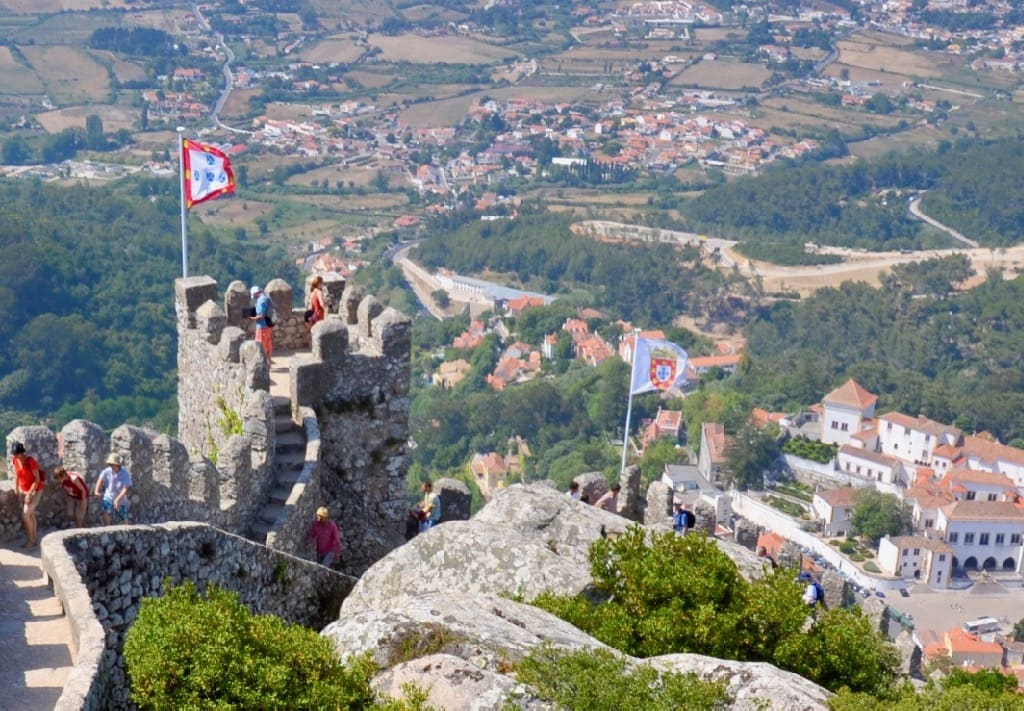
The best views over Sintra can be admired from the castle. You can even make out Sintra National Palace with its two enormous white chimneys.
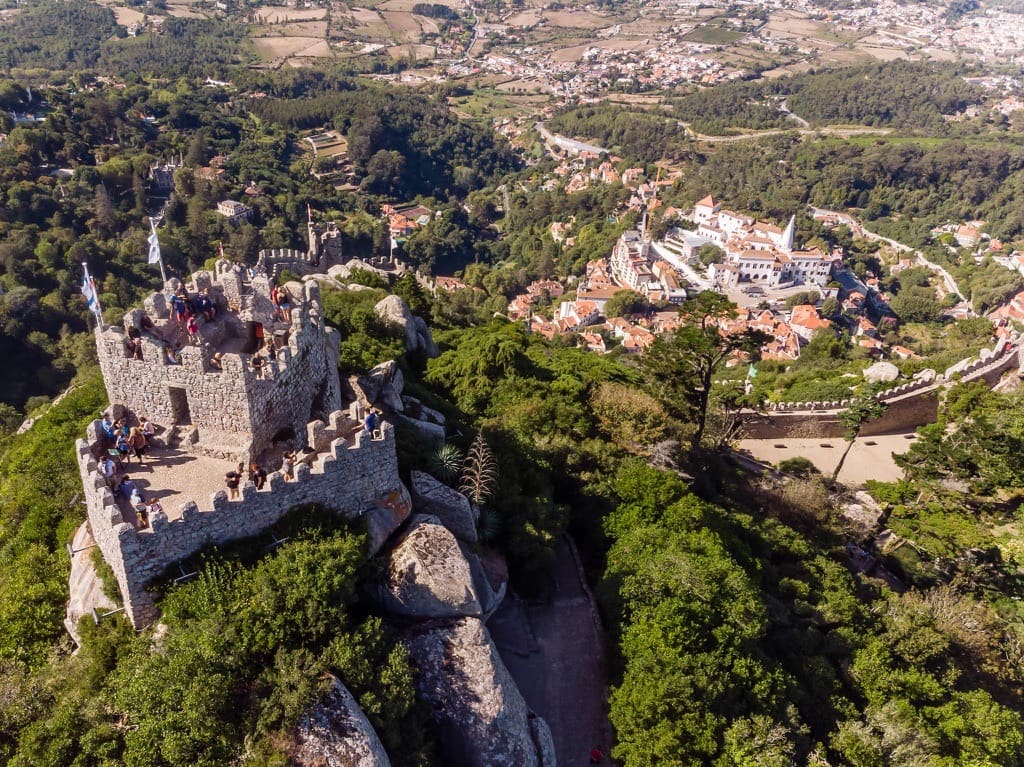
Standing on one of the castle towers must be an awesome experience.
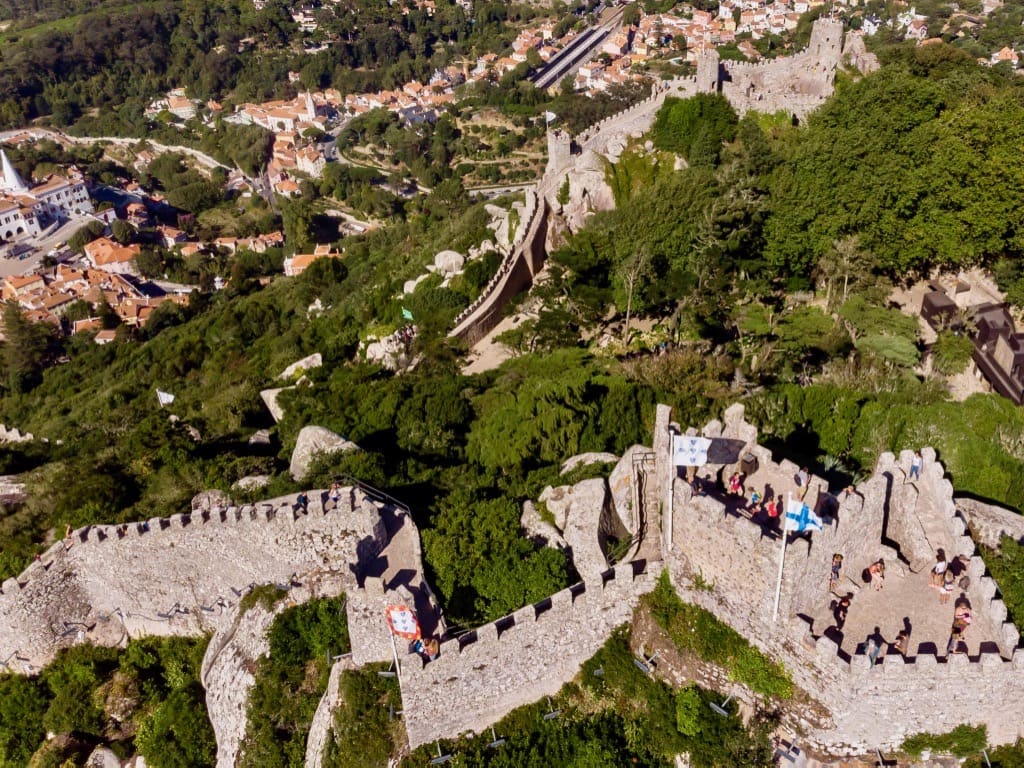
This place looks incredible.
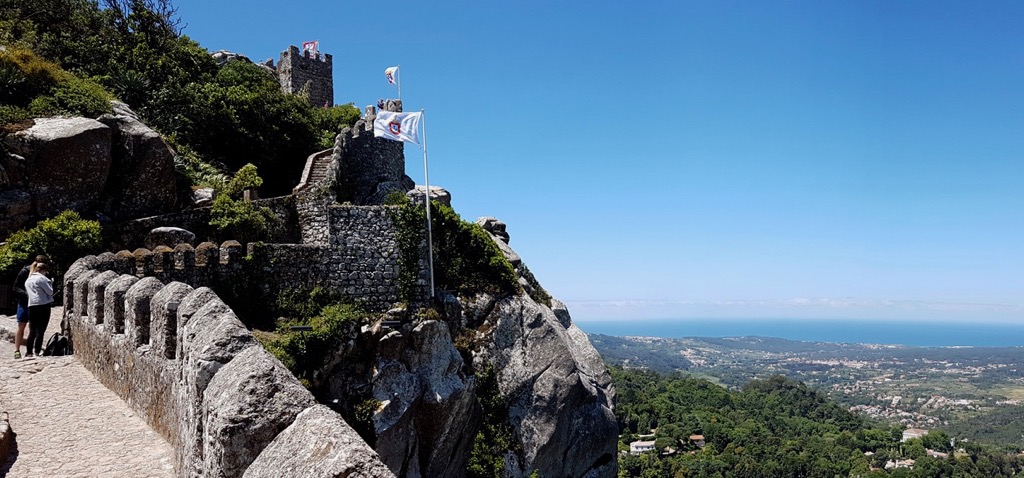
I think all of these great pictures confirm the fact that castle of the Moors shouldn’t be missed on any day trip to Sintra. What an amazing place.

You don’t have to walk the full length of the castle walls. Visit a couple of the main towers, especially the highest tower, and enjoy the views all the way to the ocean.

Here’s a view of Pena Palace from the castle.
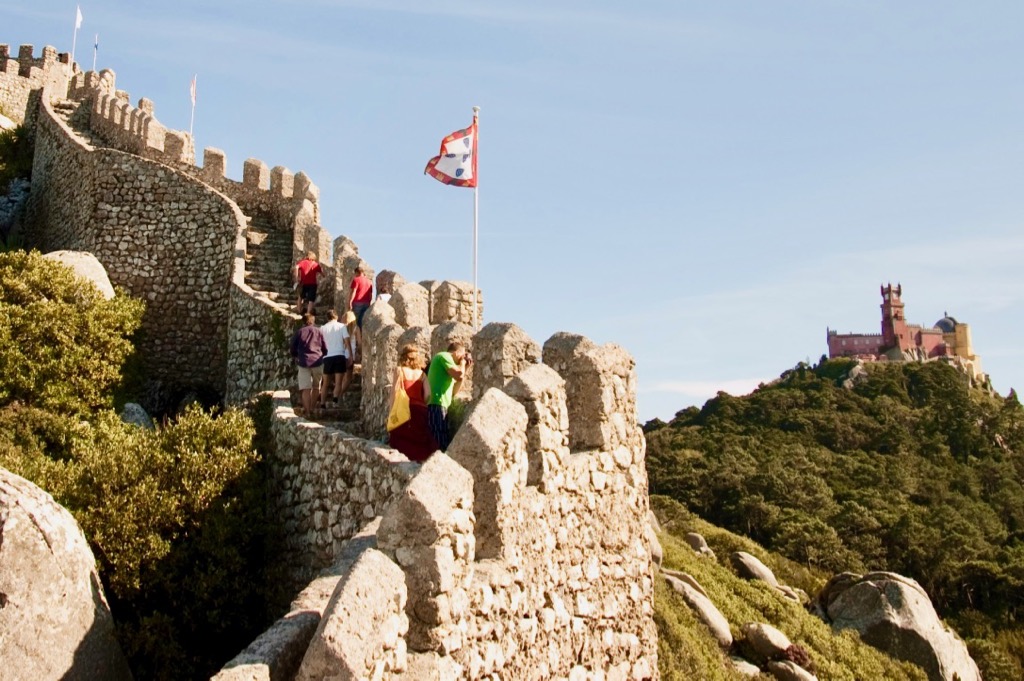
During my trip to Sintra I didn’t get to step foot on the castle grounds. I did see it from Pena Palace and also from the historical centre from the town below, near the Sintra National Palace.
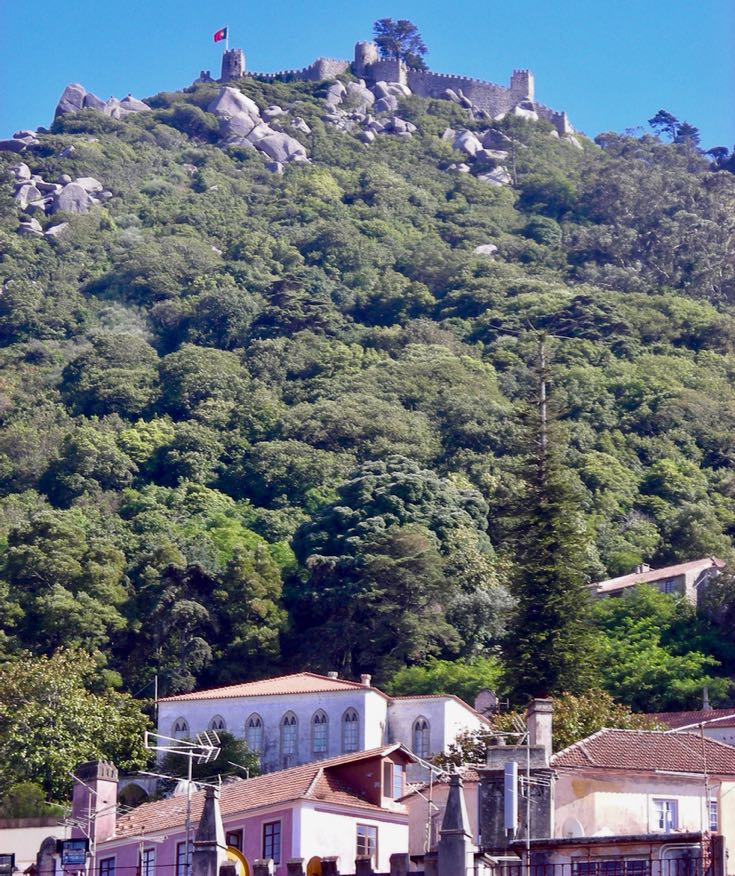
The problem was that I had left it too late in the day and by that time I felt too tired to bother going back up the mountain, so I never visited the remnants of this great looking castle.
I loved visiting a castle at Tomar, another famous castle in Portugal, so I must have been really tired. I should have visited the Moorish castle and regret it. It was so close to Pena Palace.
Tickets for Castle of the Moors
You can walk all the way up to the castle without the need to pay. You don’t even need to if you don’t want to pay. I can’t see why you wouldn’t enter though.
Opening hours: 9:30am – 8pm (last entry at 7pm)
When it’s time to leave you might want to walk down the Villa Sassetti pedestrian footpath.
Walk down the Villa Sassetti pedestrian footpath
Getting down: 7pm – 8pm (Depending on whether there’s enough daylight left)
Find out when it gets dark in Sintra before you attempt to walk down the pathway.
You have five choices to make your way down from the Moorish Castle to the town center: bus, Tuk-Tuk, taxi, Uber, and by walking.
The best option in my opinion is to walk down the Villa Sassetti pedestrian footpath.
The nature trail initially runs parallel to the road. It leads to a simple viewing platform where you can take in the views before you head down the stairs and continue down through the forest.
The path winds around the base of the Penedo da Amizade, a large sheer cliff face, which is used for recreational rock climbing.
Follow the path down to Villa Sassetti. You don’t need a ticket to visit the grounds of Villa Sassetti. Continue walking down the sloping path until you make it onto Estrada da Pena street.
Map showing the route of the Villa Sassetti pedestrian footpath in Sintra
This Villa Sassetti pedestrian footpath will take you to Villa Sassetti as shown by the green dashed lines on the map below.

Google maps doesn’t show this footpath so it’s a bit of a secret pathway to the old town.
There are two entrances to the Villa Sassetti footpath and they both soon join together as you can see.
The Villa Sassetti footpath is a great route to take because it lets you avoid all of the traffic on the roads. You’d have to be crazy to walk around the loopy roads you see on the map.
It will take about 40-60 minutes to get down using the Villa Sassetti pedestrian walkway and the beauty about it is that you’ll be going downhill, so it should be much easier than walking uphill. An added bonus is that it will also allow you to admire the gardens of Villa Sassetti.
The easier option is to just use transport to get down. Either option is fine and it all depends on how you feel at that time of day and how much daylight is left.
There you have it, my Ultimate Sintra Guide showing you the best places to visit in Sintra in 1 epic day.
Some more top tips when visiting Sintra
Piriquita is a famous pastry shop in Sintra worth visiting.
Another thing that you should know about is that you’re in Greek God territory in Sintra.
Here’s a fountain of Neptune (Poseidon), God of the sea, at The Palace of Queluz. It’s too far away to visit on your one day trip to Sintra, but if you’re in Sintra for a few days you may want to visit it.
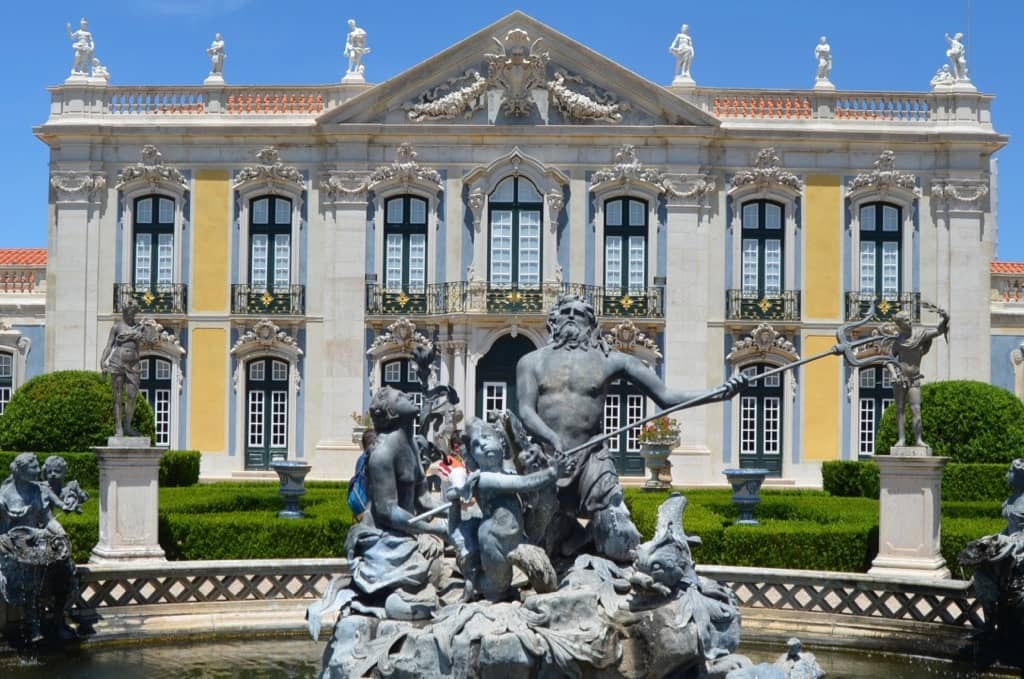
The property also has statues of Aeneas and Anchises, The Rape of Proserpine, Vertumnus and Pomona, Meleager and Atalanta, Venus and Adonis, Bacchus and Ariadne, as well as Diana and Apollo.
Remember to buy your tickets online especially for Pena Palace. You will normally be able to save about 5% on the normal purchase price by buying online. Package deals for multiple palace and castle visits can also save you money.
Buses are very easy to use in Sintra. I found them great. Just remember these important routes.
Sintra Bus no. 434 (Circuito da Pena)
All you need to remember is that bus no. 434 does is a one-directional loop bus. It only goes one way. The first bus leaves the train station at about 9:15am. Check times before you go as they can change. Maximum number of bus departures are every 15 minutes. It all depends on the time of year.
The bus route is as follows:
– Sintra train station
– The historic centre of Sintra (and the Palácio Nacional de Sintra)
– Castle of the Moors (Castelo dos Mouros)
– Pena Palace (Palácio Nacional da Pena)
– The historic centre of Sintra (and the Palácio Nacional de Sintra)
– and then back to the Sintra train station
Taking a bus to Pena Palace will take about 25 minutes.
Sintra Bus no. 435
Bus no. 435 will take you first to Quinta da Regaleira and a bit later to the Palace of Monserrate. It is also the same bus that takes you back into town. The first bus leaves the train station at about 9:40am. Check times before you go as they can change. Maximum bus departures are every 25 minutes, depending on the time of year.
Walking to Sintra’s train station at the end of the day
Depending on how you feel, you may want to walk to the train station at the end your epic day trip in Sintra. If that’s the case it will require a walk of about 1.6km, which is about 1 mile. Allow 10-15 minutes to get there from town.
Best places to stay in Sintra
If you’re lucky enough to stay in Sintra for a few nights then you might want to stay here:
Luxury Accomodation
Tivoli Palacio de Seteais (Seteais Palace), a former palace now operating as a five star hotel. It is open to the public and is conveniently located in Sintra only a couple hundred metres from Quinta da Regaleira. Something to dream about.
Sintra Marmoris Palace
Penha Longa Resort
Budget and mid-range Accomodation
Hotel Nova Sintra
Sintra1012 Boutique Guesthouse
Top Tip: You should also visit the cool neighbouring beach town of Cascais.
Pin it … Share it





